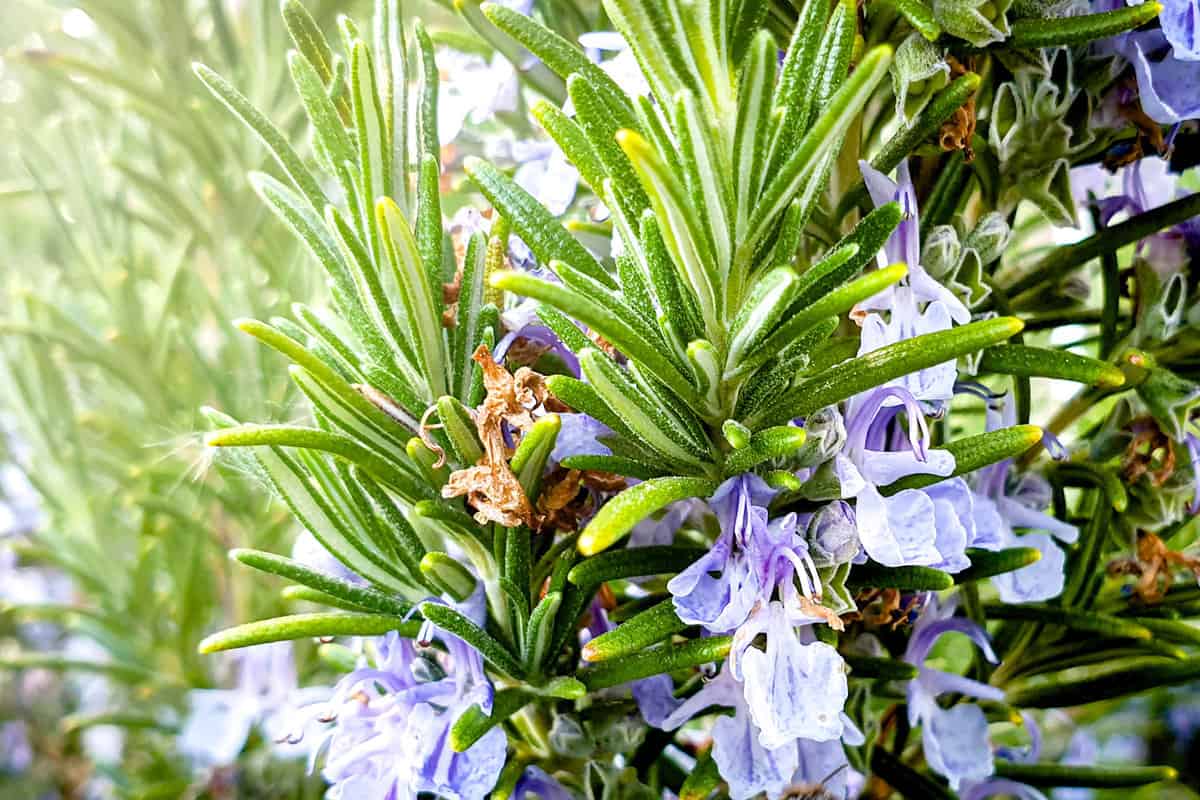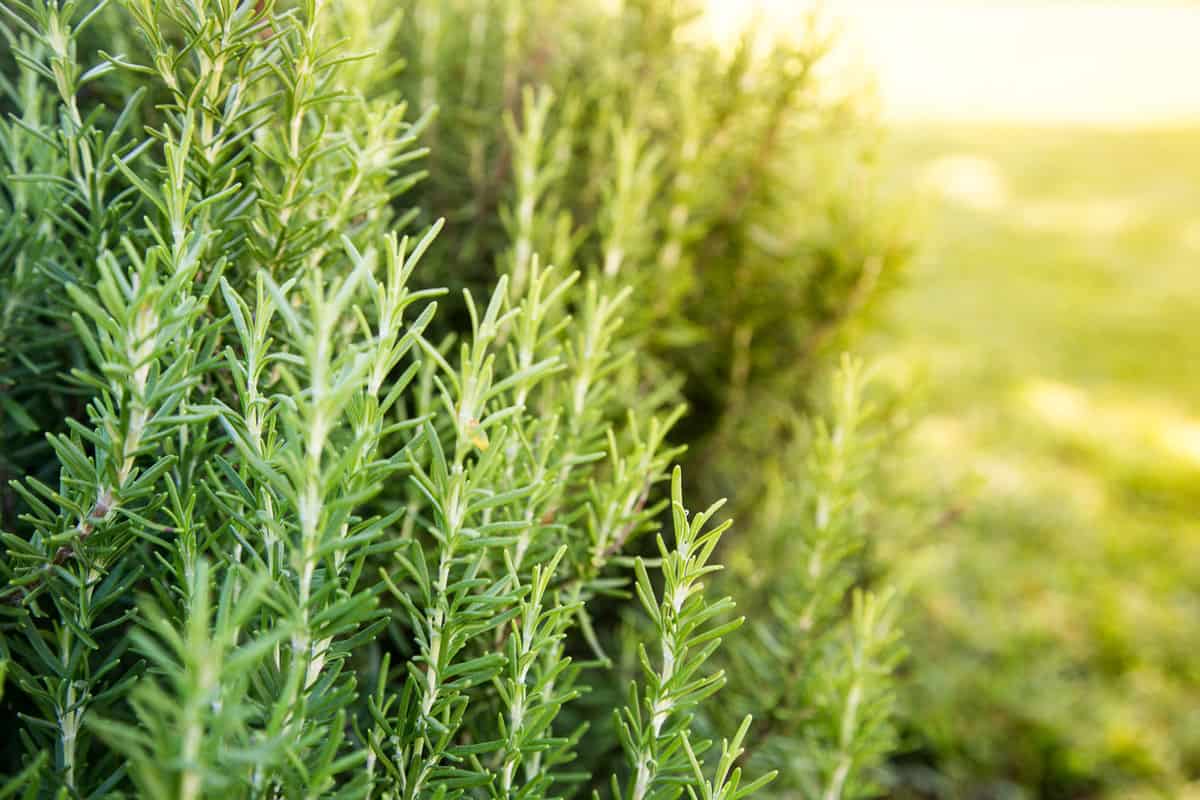Adding new plants to a garden can be confusing at times. Do you want to plant some rosemary in your yard but have no idea how much sun they need to grow? Does rosemary prefer full sun? What about growing climate and soil conditions? Well, we will dive into all of these questions below.
In general, it's best to plant rosemary somewhere it will get six or more hours of sun per day. Considering this herb species prefers full sun, you want to ensure you have yours somewhere bright, warm, and unobstructed.
Additionally, it's a good idea to plant rosemary in nutrient-rich, slightly acidic soil, so climate and ground conditions will make a difference too.
As we start, we will cover all things rosemary and discuss how much sun your plant will need. Whether you live somewhere super bright and warm or on the more moderate side, we're here to help. With that said, let's explore this topic!
![Fresh Rosemary Herb grow outdoor. Rosemary herb garden - How Much Sun Does Rosemary Need [And Can It Get Too Much?]](https://gardentabs.com/wp-content/uploads/2022/06/Sun-Paint-Brush-Strokes-on-white-background..png)
Does Rosemary Prefer Full Sun?

Yes! Rosemary does prefer to grow in places with full sun exposure. Generally, this herb does best in gardens with six or more hours of direct sunlight each day.
As we mentioned, rosemary loves warm growing conditions, so the more sunlight, the better. If you live somewhere that gets super hot, you may want to plant rosemary in partial shade.
Remember, the sun is powerful, so if you're in a place like Arizona or Nevada, partial shade may end up being the same as full sun, somewhere more moderate.
Furthermore, if you want your rosemary to grow as a perennial, plant it somewhere that will not be disturbed by tilling.
Your herbs will also need plenty of nutrients and good drainage, so soil conditions are important too.
Can I Grow Rosemary In Partial Shade?
Technically, you can grow rosemary in partial shade: don't expect it to thrive. As we said, this plant species do best with at least six hours of full sun per day.
In addition, rosemary will grow best in locations with closer to eight hours of sunlight, which is not possible in partially shaded areas.
For this reason, you can try growing rosemary in a place with partial shade that gets between four and six hours of direct light, but again, you may have trouble.
On top of that, if your plant is in the shade, some conditions need to be met. For example, a partially shaded rosemary herb won't get as much warmth if it's not under direct light for six-plus hours.
So the ground will need good drainage to prevent waterlogging and root rot. Moreover, your plant will need a dry climate and great air circulation.
That might be doable for those in the desert, but everyone else should try to keep their rosemary in a bright spot if possible. Again, this herb can tolerate moderate shade, but not so much that the sun can't reach it.
Where Does Rosemary Grow Best?
When it comes to where the best place for growing rosemary is, this depends on climate. Generally, rosemary will thrive in USDA growing zone 5a, but that is a technicality.
As we covered above, your rosemary should be healthy if it receives 6-8 hours of full sun daily.
For states where rosemary thrives, California, Florida, Arizona, Texas, and Nevada all come to mind. In addition, this herb is native to the Mediterranean, so if your climate is similar, you should be fine to plant some rosemary in your yard.
That said, the ground where you plant rosemary also needs to check off a few boxes. Most importantly, rosemary needs well-drained, loamy, slightly acidic soil.
Ideally, the pH level of the ground should be between 6.0 and 7.0, so that's something to keep in mind. Additionally, rosemary loves its privacy, so if you plan on tilling the ground, keep your herbs away.
However, if you're in a warmer environment, your rosemary may need less sand in its soil. Considering that the desert isn't seeing rain as much as the northeast or coastline, having the ground drain too fast can be detrimental.
To prevent your rosemary from becoming too dry, we recommend adding natural matter to its base, like compost, mulch, or garden trimmings.
Is It Better To Grow Rosemary In The Ground Or A Pot?
For those wondering where the best place to grow rosemary is, this can depend. As we mentioned, soil conditions can make or break a rosemary's success.
So if the ground where you live is extremely dense or very low in acidity, you may want to consider pot-growing instead. Adding to that, rosemary does very well in pots and planters.
Generally, as long as you grow yours in soil-based, peat-free compost, you should notice your rosemary thrive. However, the sun is still vital here, so make sure your pot is somewhere extra bright and warm.
According to Gardeners World, adding rocks to the bottom of a rosemary's pot can be helpful. Furthermore, you want to keep your herb well-watered during the dryer summer months.
Remember, a pot doesn't hold excess water like the ground, which can make for a drought-intolerant plant if the temperatures rise.
It's also essential to bring your rosemary inside if the weather goes below 30 degrees. Considering this plant species loves the sun and warm weather, anything too cold can/will kill it.
Compressed Organic Potting Soil
This organic potting soil is peat-free, has coconut coir and worm castings, expands up to 4x with water, is kid and pet-friendly, and fills up to three gallons.
Check out this potting mix on Amazon.
How Much Water Does Rosemary Need?

In general, rosemary won't need too much water. Many experts recommend watering a rosemary plant every 1-2 weeks, so this won't need to be done too frequently.
However, if you live in a dry, desert climate with hotter temperatures, you may want to up your watering. For example, if it's summertime in Arizona, you will likely need water once or twice weekly.
Before doing this, make sure to feel around your plant's soil/base; if the dirt is dry, it's time for water. Another thing to consider is how often it rains where you live.
As we covered, rosemary needs soil with good drainage, as they are prone to root rot. For this reason, if it recently rained, you may want to hold off on watering further.
Even if it's hot, the ground tends to store moisture a foot or two beneath the surface, which feeds your plant between waterings. Adding more water to the soil can create flooding near a rosemary's root system, which could kill it.
So again, if it's recently rained or your plant's soil feels damp, don't water it.
What Happens If You Overwater Rosemary?
If you overwater a rosemary plant, expect a few things to happen. First, you will notice the ground around your herb is extremely wet. You may even see a pool of water form around this area.
Second, you might notice your rosemary's leaves/flowers droop and discolor. This can look like a yellowing effect throughout your plant, which should subside once the ground dries out.
With that said, overwatering rosemary regularly can kill it. Especially if your herb doesn't get 6-8 hours of direct sunlight per day, waterlogging and root rot can become a serious problem.
According to Evergreen Seeds, rosemary prefers to be watered only when the first few inches of the soil become dry, so you may want to invest in a moisture tester.
SONKIR Soil Moisture/Light/pH Tester
This soil tester reads water, light, and pH levels, works indoors and outside, has double-needle detection for accuracy, has a 7.9-inch probe, and doesn't need batteries.
View this soil meter on Amazon here.
Can Rosemary Get Too Much Sun?

Depending on the circumstance, rosemary can get too much sun. Although this isn't as likely as overwatering, rosemary can become burned by the sun if it's scorching out.
Luckily, this shouldn't happen outside of the high desert, so most places won't experience such high heat levels. Furthermore, if your rosemary looks extra dry or has burnt leaves, try watering it.
You can also use plant covers around the affected herbs, which should give them time to heal. It's also important to protect your plants during the summer by adding more soil around them, which can help retain moisture better.
As we said, it may be a good idea to plant your rosemary somewhere with partial shade if the heat where you grow it is extreme, so that's another way to prevent burning.
Is Rosemary Difficult To Grow?

No, rosemary won't be very hard to grow if you give your plant the right conditions. Although seed-growing rosemary can be more difficult than other herbs, the upkeep is relatively minimal once you have a mature plant.
One thing to remember about rosemary is that it is a slow grower. Many gardeners mistake this slower-growing speed for something wrong with their rosemary, which isn't true.
As long as you give your plant good draining, slightly acidic loamy soil, it should thrive. Additionally, planting your rosemary in a bright location with 6-8 hours of sunlight daily will keep it healthy.
To Finish
Whether you want to start an herb garden or have rosemary in your garden, it's essential to know how much sun it will need. We found that rosemary prefers at least six hours of direct sun exposure each day.
Although it can grow in partial shade, you won't have as much success as plants in sunnier conditions. In addition, rosemary doesn't need much watering, so limit your schedule to once every week or two.
Regardless, find soil for your rosemary that has great drainage and a slightly acidic pH, and don't be afraid to grow yours in a pot if you prefer.
Made it to the end? Check out these helpful related plant posts below!
How Often To Water Plants In Clay Soil [And How To Make It Fertile]


